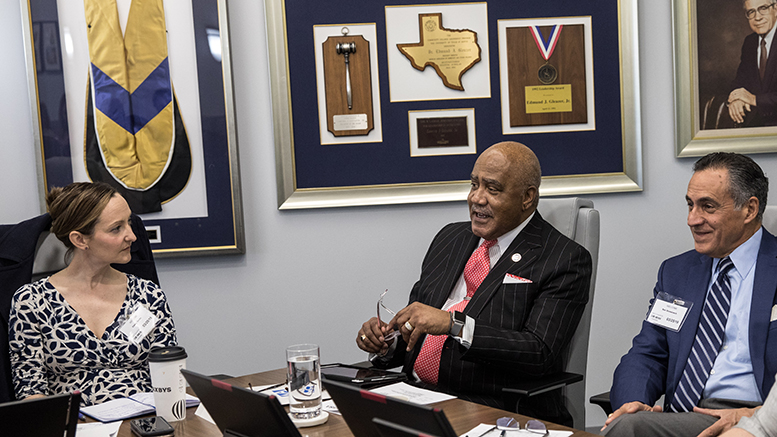There is strong bipartisan support for reauthorizing the Higher Education Act this year, particularly in the Senate, but there are plenty of policy issues that lawmakers need to work out, according to a U.S. Education Department (ED) official.
One idea being discussed as a way to better prepare students for college-level work and to curb college costs is to allow dual-enrollment students to tap Pell grants, said Casey Sacks, ED’s deputy assistant secretary for community colleges. Sacks, who spoke Monday at a joint meeting of the American Association of Community Colleges (AACC) and AASA, The School Superintendents Association on college and career readiness, noted that could present a problem because of the lifetime limit on how much Pell funds a student can access. High school students who use the grants for dual enrollment might not be able to get financial aid later for a bachelor’s degree program, she said.
AACC opposes expanding Pell for dual enrollment.
“The lifetime limit puts student in a precarious position,” said AACC President Walter Bumphus. “We don’t want to have students spend half their money before they get to a university or even to a community college.”
Some dual enrollment programs are free, but students sometimes unknowingly apply for Pell grants or take out student loans, Bumphus said. Dual enrollment programs are growing, with about 20 percent of community college students nationwide dually enrolled, reaching as high as 80 percent at some colleges, he said.
Pell for prisons
There is also much discussion around the HEA reauthorization about loan servicing – including loan repaying terms, loan forgiveness and holding colleges more accountable for student aid – and there is bipartisan support for simplifying the Free Application for Federal Student Aid, Sacks said.
Among other issues that have gained traction in both parties and chambers is extending Pell eligibility to certain inmates, she said. Issues that need to be resolved include whether the program should be limited to inmates nearing their release and what to do about students in prison who are in default.
The ability-to-benefit requirement for financial aid is another issue, Sacks said. Currently, states can have students without a high school diploma take the AccuPlacer test or complete six credit hours.
“We need a different process,” she said, noting that states can come up with alternative requirements.
Some of the key HEA issues where there are disagreements involve how to handle proprietary institutions and how to address sexual assault and misconduct under Title IX, Sacks added.
Perkins plans
Since the Perkins Act was reauthorized last summer, Sacks has worked with state directors to write new state Perkins plans. One new requirement calls for states to conduct a local needs assessment, so students are trained for jobs in demand. If students are interested in cosmetology but there’s a greater demand for people with information technology skills, that is what local programs should focus on, Sacks said.
“There is no need to put our limited resources in areas where there is no employment,” she said.
Noting that states determine how their Perkins funds are allocated, Sacks urged college and K-12 leaders to get to know their state career and technical education director. “Get involved and make sure your voice is at the table” when the state plan is being developed, she said.
One challenge with the Perkins program is ensuring equity, particularly around race and in the STEM fields, Sacks said. If a welding program that leads to high-paying jobs doesn’t attract enough women, for example, that needs to be addressed.
In an unrelated issue, Sacks said her office will host a series of meetings this summer with AACC on how rural community colleges can better compete in getting federal grants.
“Writing a grant is a big lift. It’s a solid couple of months of work,” she said, and many colleges in rural areas don’t have the staff or resources to do that.
Apprenticeships
The biggest new initiative under way at AACC is a program to help colleges establish effective apprenticeships. The goal of a new $20 million partnership with the U.S. Department of Labor (DOL) is to create 16,000 new apprentices within the next three years.
Colleges have long had various types of work-based learning programs, but “we don’t typically use apprenticeships in a meaningful way across all our networks,” said Jennifer Worth, senior vice president for workforce and economic development at AACC. These efforts range from brief online courses – which are not particularly effective – to intensive two-year, one-on-one programs that are effective but not scaleable.
Worth said the apprenticeship partnership with DOL has four strands:
- A new AACC task force on apprenticeships – comprising mostly of community college presidents and chancellors – will meet for the first time at the AACC annual convention next month.
- The association will work with DOL to develop a website with high-quality, transparent information about community college apprenticeship programs. Comparing it to Match.com, Worth said the goal is to make it easier to connect apprenticeship programs with employers.
- AACC will identify up to 80 locations across the country – individual colleges or college systems – to establish apprenticeship programs.
- Four selected industry partners will work with AACC on developing apprenticeships. The companies will soon be announced.
“There is a cultural issue with apprenticeships,” said AASA Executive Director Dan Domenech. Parents who are pushing their children into four-year colleges “have to be convinced that an apprenticeship is a legitimate program with big benefits.”

